cti4sw
Bronze Member
- Joined
- Jul 2, 2012
- Messages
- 1,555
- Reaction score
- 919
- Golden Thread
- 1
- Location
- Pennsylvania
- 🥇 Banner finds
- 1
- Detector(s) used
- Minelab Equinox 600, Garrett AT Pro, Pro Pointer
- Primary Interest:
- Relic Hunting
Well, I think it's fantastic, anyway. It made my weekend.
My buddy Jesse and I hit an old park near his house where he'd previously found wheat cents for a few hours until dusk after work on Friday. He found a lot of clad with his AT Pro; I found a 1955 wheat and a .250 HP shell casing with a live primer (no powder, no bullet).
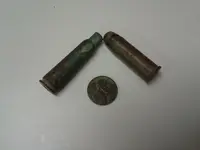
We wanted to hit the Jersey shore on Saturday, specifically the beach where Jesse found his Spanish dollar from 1784. About 5 miles over the bridge from PA his idler wheel tore up his fan belt, and we had to wait an agonizing 2 hours for the AAA tow truck to arrive The trip back to his house was compensated by the tow truck driver, who turned out to be an older gentleman who was also an MDer! He said he used a "Blazer 7200" or something like that (which Jesse Googled but couldn't find, lol) and gave us some tips on a few spots he knew of. When we got back to Jesse's house, I went ahead to a location around the corner that Jesse's research showed had some undefined colonial activity while I waited for him to get the parts he'd need to fix his truck the next day.
The trip back to his house was compensated by the tow truck driver, who turned out to be an older gentleman who was also an MDer! He said he used a "Blazer 7200" or something like that (which Jesse Googled but couldn't find, lol) and gave us some tips on a few spots he knew of. When we got back to Jesse's house, I went ahead to a location around the corner that Jesse's research showed had some undefined colonial activity while I waited for him to get the parts he'd need to fix his truck the next day.
According to Jesse, the site where I made this find used to be a 19th century inn on one side of the creek and a colonial-era gunpowder mill that supported the Rev. War on the other side. Unfortunately, the online local history resources only provide atlases back to about 1870, and while the mill apparently did not survive to the later atlases made in the latter part of the century, the diverting culvert that powered it was shown. I didn't find anything on the old inn either; Jesse said his info came from a century-old postcard he saw in a book. I did find pictures/paintings of the creek's waterfall there but the angles don't have the inn nor the mill. From my own research, it seemed that in order for the inn to have been a 19th-century inn as Jesse said, its existence would have to predate the 1870 atlas, which put both the inn and mill sites on private farms.
So I get there, and it's less an actual park as it is a small grassy copse with a few tire swings. I started swinging to discover that the field is littered with iron junk. I switched to disc mode to filter out all but the densest junk metal and coinage. Near a thick tree with one of the tire swings, I find this:
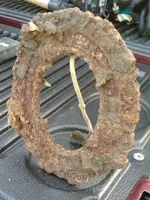
At first I didn't know what it was. It was face down in the dirt, and I thought the stand was a separate item that was fused to it by rust. Then I saw the three clasps that hold the image in place, and I realized... it's a picture frame Jesse drove up shortly after, and the picture was taken on the tailgate of his other truck (lol). We then walked across the creek to the mill site side, which we also found out used to be wooded but was cleared by Sunoco during the laying of a pipeline. Neither of us found anything except iron junk. The iron was so predominant in the soil there (not even including Sunoco's pipe) that neither my BH nor his AT Pro could pick through it. So that ended our day when dusk finally rolled over.
Jesse drove up shortly after, and the picture was taken on the tailgate of his other truck (lol). We then walked across the creek to the mill site side, which we also found out used to be wooded but was cleared by Sunoco during the laying of a pipeline. Neither of us found anything except iron junk. The iron was so predominant in the soil there (not even including Sunoco's pipe) that neither my BH nor his AT Pro could pick through it. So that ended our day when dusk finally rolled over.
After I cleaned the dirt off the frame, I could really see the ornate detail of the frame - though it was still completely rusted over. My mom commented that if it cleaned up nicely, she wouldn't mind having it I said, "We'll see
I said, "We'll see  " Sunday was supposed to be my MD-free day, but my wife's 5-year-old nephew bugged me to do some spot hunting in his yard with him. We found about 14 pennies, 2 dimes, a quarter, and the .44 magnum Remington revolver round in the first picture.
" Sunday was supposed to be my MD-free day, but my wife's 5-year-old nephew bugged me to do some spot hunting in his yard with him. We found about 14 pennies, 2 dimes, a quarter, and the .44 magnum Remington revolver round in the first picture.
The picture frame is soaking in ACV right now... I'll definitely be posting progress pics!




EDIT: The pics at the bottom that I can't seem to get rid of are of a valve wheel on the mill culvert. According to local history it was operated by a Dr. Robert Harris to make gunpowder in support of the 1776-1777 campaigns of the Revolutionary War. An older stone house sits adjacent to the ruins on the culvert.
12/3/2012 I did get a response today from a local college library about the inn, which included the name (which isn't important). It operated from about the 1890s to 1960 and is featured on the online local history site's 1902 and 1908/9 atlases. (They had no information on the older gunpowder mill.) That doesn't necessarily mean my frame can't be older than 1890, of course. When it's de-rusted I'll likely take it to an antiques dealer for a date estimate.
12/6/12 Took the frame out of its ACV bath for its first rinse & scrub. Some of the rust has come off, but there is still quite a bit caked on. The frame appears to be copper-plated iron, and the detail is starting to show through a little. An engraved number, "2100", has shown through but its meaning isn't clear yet. The pictures from today's work:
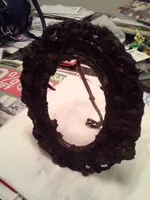
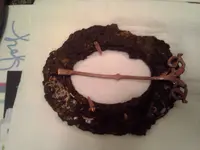
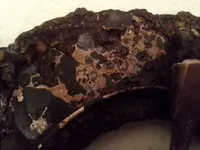
12/11/12 After 10 days in the ACV bath the rust is softening and coming off easier. I found my old handheld Dremel engraver and decided to give it a try on some of the holes and thicker encrustation. It worked like a charm, and it did not leave any scratches on the metal (that I could see). Some of the encrustation was too thick still even for the dremel, so the frame must return to the ACV bath for a few more days. Progress pics are as follows:
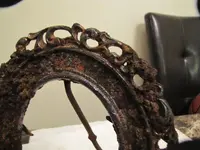
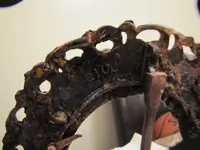
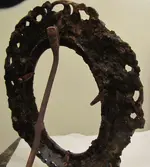
My buddy Jesse and I hit an old park near his house where he'd previously found wheat cents for a few hours until dusk after work on Friday. He found a lot of clad with his AT Pro; I found a 1955 wheat and a .250 HP shell casing with a live primer (no powder, no bullet).

We wanted to hit the Jersey shore on Saturday, specifically the beach where Jesse found his Spanish dollar from 1784. About 5 miles over the bridge from PA his idler wheel tore up his fan belt, and we had to wait an agonizing 2 hours for the AAA tow truck to arrive
 The trip back to his house was compensated by the tow truck driver, who turned out to be an older gentleman who was also an MDer! He said he used a "Blazer 7200" or something like that (which Jesse Googled but couldn't find, lol) and gave us some tips on a few spots he knew of. When we got back to Jesse's house, I went ahead to a location around the corner that Jesse's research showed had some undefined colonial activity while I waited for him to get the parts he'd need to fix his truck the next day.
The trip back to his house was compensated by the tow truck driver, who turned out to be an older gentleman who was also an MDer! He said he used a "Blazer 7200" or something like that (which Jesse Googled but couldn't find, lol) and gave us some tips on a few spots he knew of. When we got back to Jesse's house, I went ahead to a location around the corner that Jesse's research showed had some undefined colonial activity while I waited for him to get the parts he'd need to fix his truck the next day.According to Jesse, the site where I made this find used to be a 19th century inn on one side of the creek and a colonial-era gunpowder mill that supported the Rev. War on the other side. Unfortunately, the online local history resources only provide atlases back to about 1870, and while the mill apparently did not survive to the later atlases made in the latter part of the century, the diverting culvert that powered it was shown. I didn't find anything on the old inn either; Jesse said his info came from a century-old postcard he saw in a book. I did find pictures/paintings of the creek's waterfall there but the angles don't have the inn nor the mill. From my own research, it seemed that in order for the inn to have been a 19th-century inn as Jesse said, its existence would have to predate the 1870 atlas, which put both the inn and mill sites on private farms.
So I get there, and it's less an actual park as it is a small grassy copse with a few tire swings. I started swinging to discover that the field is littered with iron junk. I switched to disc mode to filter out all but the densest junk metal and coinage. Near a thick tree with one of the tire swings, I find this:

At first I didn't know what it was. It was face down in the dirt, and I thought the stand was a separate item that was fused to it by rust. Then I saw the three clasps that hold the image in place, and I realized... it's a picture frame
After I cleaned the dirt off the frame, I could really see the ornate detail of the frame - though it was still completely rusted over. My mom commented that if it cleaned up nicely, she wouldn't mind having it
 I said, "We'll see
I said, "We'll see  " Sunday was supposed to be my MD-free day, but my wife's 5-year-old nephew bugged me to do some spot hunting in his yard with him. We found about 14 pennies, 2 dimes, a quarter, and the .44 magnum Remington revolver round in the first picture.
" Sunday was supposed to be my MD-free day, but my wife's 5-year-old nephew bugged me to do some spot hunting in his yard with him. We found about 14 pennies, 2 dimes, a quarter, and the .44 magnum Remington revolver round in the first picture.The picture frame is soaking in ACV right now... I'll definitely be posting progress pics!





EDIT: The pics at the bottom that I can't seem to get rid of are of a valve wheel on the mill culvert. According to local history it was operated by a Dr. Robert Harris to make gunpowder in support of the 1776-1777 campaigns of the Revolutionary War. An older stone house sits adjacent to the ruins on the culvert.
12/3/2012 I did get a response today from a local college library about the inn, which included the name (which isn't important). It operated from about the 1890s to 1960 and is featured on the online local history site's 1902 and 1908/9 atlases. (They had no information on the older gunpowder mill.) That doesn't necessarily mean my frame can't be older than 1890, of course. When it's de-rusted I'll likely take it to an antiques dealer for a date estimate.
12/6/12 Took the frame out of its ACV bath for its first rinse & scrub. Some of the rust has come off, but there is still quite a bit caked on. The frame appears to be copper-plated iron, and the detail is starting to show through a little. An engraved number, "2100", has shown through but its meaning isn't clear yet. The pictures from today's work:



12/11/12 After 10 days in the ACV bath the rust is softening and coming off easier. I found my old handheld Dremel engraver and decided to give it a try on some of the holes and thicker encrustation. It worked like a charm, and it did not leave any scratches on the metal (that I could see). Some of the encrustation was too thick still even for the dremel, so the frame must return to the ACV bath for a few more days. Progress pics are as follows:



Amazon Forum Fav 👍
Last edited:
Upvote
1



